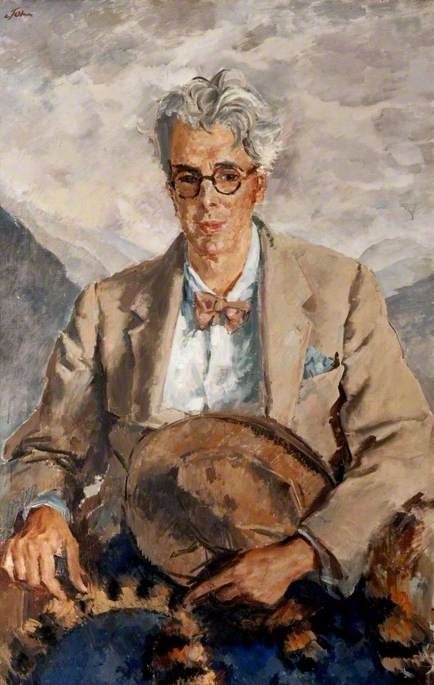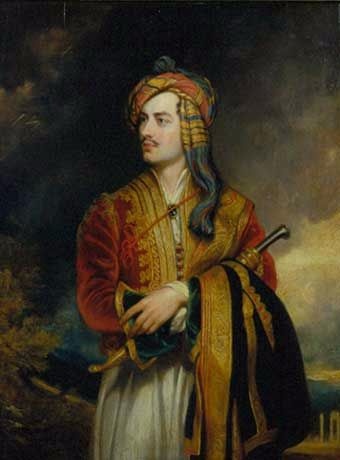A good poem is liked a surprise. It can thrill, move or shake you awake; it can show you a new way of looking at everyday things. The American poet Robert Frost described this feeling as 'the surprise of remembering something I didn't know'.
The poem has been part of our way of life for hundred of years. And poets have been honored from the early times. Geoffrey Chaucer (1340?-1400), often called the father of English poetry, was given a pension by King Edward III. Later, court poets were given a salary and the title poet laureate. ('Laureate' means 'glorious' or 'honoured'.) The pre-sent day poet laureate receives only a small salary, but his title carries honor and respect.
Chaucer, of course, was the first great English poet. A hundred years or so after his death, poets began to express themselves in sonnets and blank verse.
NEW VERSE FORMS
Sir Thomas Wyatt (1503-42) and the Earl of Surrey (1517-47) were the first poets who used sonnets and blank verse in English. These new verse forms greatly influenced all later English poetry. The sonnet, a 14-line poem, came from Italy. Blank verse is a verse without rhythms, It gives poets much greater freedom because they do not have to find words that rhyme with those already written.
Wyatt and the Earl of Surrey were members of the court of King Henry V. After their death, their work printed in a widely read book called Tottel's Miscellany.
THE ELIZABETHAN AGE
The reign of Elizabeth I produces some wonderful poets including the greatest of them all, William Shakespeare. They were exciting times. England was the leading sea power, and explorers were opening the way for settlers to start a new life in the faraway world of the Americas. Everywhere there was a spirit of adventures and excitements. The example set by the Queen, and the events of the day, inspired many poets to write flowery, formal verse.
One of the earliest and the best Elizabethan poets was Sir Philip Sidney (1554-86). A gallant member of the Queen's court, he was also a master of the sonnet. His finest work was a series of the sonnets called Astrophel and Stella, which describes an unhappy love affair.
Sidney was a friend of Edmund Spenser (1552?-99) who is perhaps the greatest of the early Elizabethan poets. Spenser is sometimes called the 'poet's poet' because he influenced so many others. The Faerie Queene is Spencer's greatest work. The poet is a tribute to Queen Elizabeth, who appears in it under different names, chiefly Gloriana. It is also a moral tale of a brave's champion fight against evil.
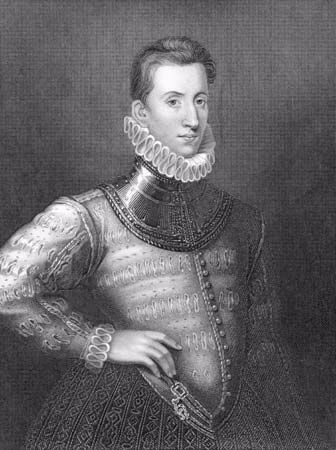 Sir Philip Sidney, courtier and master of the sonnet.
Sir Philip Sidney, courtier and master of the sonnet.
POETRY IN THE 1600s
In the 17th century England produced three great poets, all with the Christian name of John- John Donne, John Milton, and John Dryden. There were also many other good poets and new ways of writing poetry were tried and adopted.
It was a dramatic century. Half-way through it, England was hit by a wave of Puritanism. The Puritans wanted to simplify or 'purify' the Church and its methods. They had a great influence on literature as well as on religion and politics.
CAVALIER POETS-ALL THE KING'S MEN
Among the poets of the first half of the 17th century were a group who came to be known as the Cavalier poets. They supported King Charles I, who was against what the Puritans wanted to do.
Courtly and light-spirited, they write romantic lyrics. Lyrical poetry deals with feeling and emotion. Robert Herrick (1591-1674) wrote many poems including ' To Daffodils' and that which begins, 'Gather ye rosebuds...'
Sir John Suckling (1609-42) and Richard Lovelace (1681-58) are the other well-known Cavalier poets.
THE APPEAL TO THOUGHT
Another group of poets wrote about metaphysics-the real nature of man and his world. They became known as the metaphysical poets. Although many of them also wrote in the lighter fashion of Cavalier poets, they rebelled against what they felt were unimportant, without subjects such as nymphs, fauns and other imaginary creatures of the fields, woods, and streams. They dealt with deeper, often religious subjects. Their poems were usually puzzling and difficult to understand. Their work has had a strong influence on poets of our own times.
John Donne (1572-1631) was the chief voice of this poetic movement. He was a deep-thinking, emotional man. In spite of his love of pleasure, he became a priest and was a favorite preacher of both James I and Charles I. Quotations from some of his works became familiar around the world when they were used by later authors as titles for their books. For instance, in this Devotions there are the lines,
'No man is an island. . . and therefore never send to know for whom the bell tolls; it tolls for thee.'
Another poem, called simply 'Song', begins, 'Go and catch a falling star...'
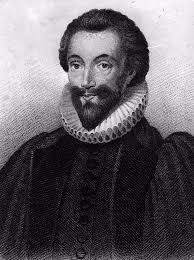 John Donne was a fine poet and writer of religious prose. His sermons are still read today.
John Donne was a fine poet and writer of religious prose. His sermons are still read today.
JOHN MILTON, THE BLIND GENIUS
The poet most concerned with the political events of his time, and the literary giant of the 17th century was John Milton (1608-74). His talent was obvious in his early work. The twin poems 'L' Allegro' and 'll Penseroso' presents two views of life-the first of a happy, lively man, the seconds of a sadder, thoughtful man.
Milton to the side of parliament and Puritan during the Civil War (1642-49), and he wrote pamphlets supporting King Charles I's execution. When Oliver Cromwell ruled England, he served as Cromwell's Latin secretary and composed many state documents.
In 1652 Milton became blind. All these major poems from that time were written under this terrible handicap. With great effort, he composed all his poems in his mind. He then dictated the words to his daughters, who wrote them down.
When the monarchy was restored and King Charles II came to the throne in 1660, Milton was in real danger. He was heavily fined, but three things helped to save his life:
- his fame as a poet
- his blindness
- his influence of his friends
In the next few years, Milton produced three masterpieces:
- Paradise Lost that tells of war in heaven, Satan's defeat and the temptation of Adam and Eve
- Paradise Regained that is a continuation of the Paradise Lost
- Samson Agonistes which is his third poetic masterpiece that is about the tragedy.
Milton had no equal in his time. John Dryden, the third great poet of those days, praised him generously. He said of him,
'This man cuts us all out, and the ancients too.'
JOHN DRYDEN, THE GREAT MOCKER
John Dryden (1631-1700), besides being an outstanding poet, was also a famous playwright, critic, and essayist. In 1668 he was named poet laureate.
Dryden, like Milton, also took part in political events of his time. His biting, mocking poem 'Absalom and Achitophel' attacked the rebel leaders who opposed King Charles II.
Dryden's name is linked with the couplet, a pair of lines whose end words rhyme, He is famous for his heroic couplets. These were written in the manner of Latin and Greek heroic verse (poems that told about heroes and their deeds) particularly those by Homer and Virgil.
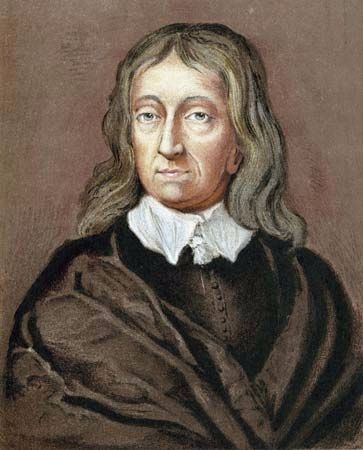
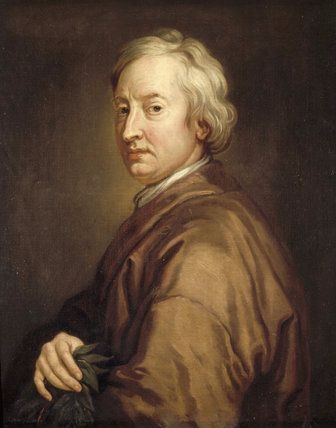 The greatest writer of the 17th century was the blind poet John Milton (above). Like Milton, the poet laureate John Dryden (below) also wrote political pieces.
The greatest writer of the 17th century was the blind poet John Milton (above). Like Milton, the poet laureate John Dryden (below) also wrote political pieces.
THE AGE OF REASON
The 18th century was an age of thinkers. Writers and thinkers questioned all facts and beliefs and argued among themselves. Men gathered in London clubs for lively conversations, and literary circle flourished. The satire making fun of people and things in a witty fashion-expressed the spirit of the time.
Alexander Pope (1688-1744) was the best-known poet of the age. His 'The Rape of the Lock' was written in the mock-heroic style, a style that became very popular. This kind of poem made fun of earlier poems that described the brave deeds of great heroes. The hero of 'The Rape of the Lock' does nothing more daring that snip a lock off the heroine's hair. In his long poem, 'The Dunciad' Pope made good use of the couplet.
Some lines of Pope's that are often quoted today are:
A little learning is a dangerous thing
To err is human, to forgive is divine
For fools rush in where angels fear to tread
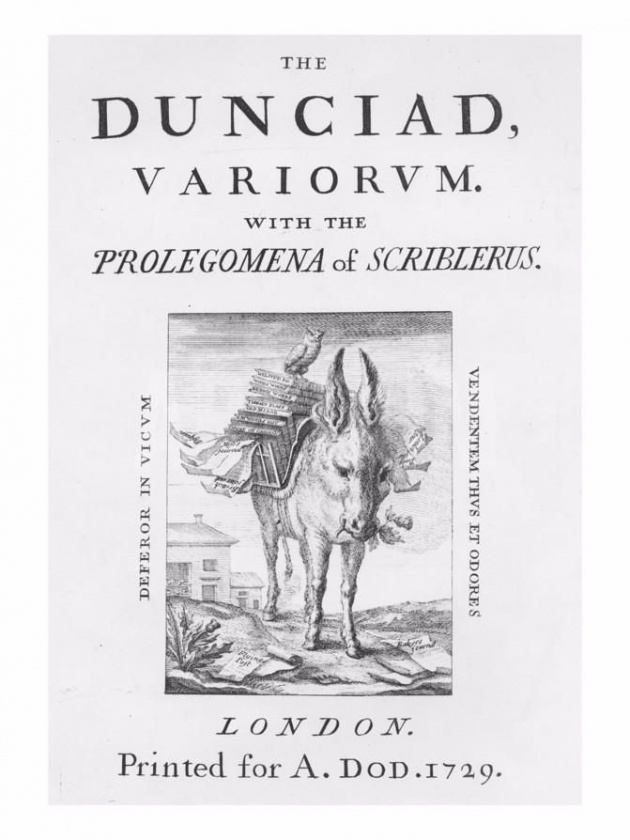
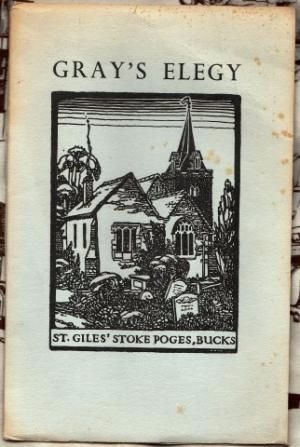 The title page of Alexander Pope's long poem, 'The Dunciad'(above). Stoke Poges Churchyard was the scene of Thomas Gray's famous poem, 'Elegey Written in a Country Churchyard'.
The title page of Alexander Pope's long poem, 'The Dunciad'(above). Stoke Poges Churchyard was the scene of Thomas Gray's famous poem, 'Elegey Written in a Country Churchyard'.
The great wit of the age was Dr. Samuel Johnson (1709-84). Dr. Johnson was best known for his dictionary, which was published in 1755. But he also wrote poems are 'London' and 'The Vanity of Human Wishes'. Johnson also produced a long series of 'Lives of the Poets', and critical studies of Shakespeare.
Other poets of the time turned to nature for inspiration. Thomas Gray (1716-71) wrote one of the most quoted of English poems, ' Elegy Written in a Country Churchyard', which begins:
The curfew tolls the knell of parting day,
The Lowing herd wind slowly o'er the lea,
The ploughman homeward plods his weary way,
And leaves the world to darkness and to me.
William Cowper (1731-1800) also wrote nature poems, as well as the humorous ballad 'John Gilpin'. The ballad (a kind of story in verse) tells of 'linen-draper bold' whose borrowed horse runs away with him on his 20th wedding anniversary.
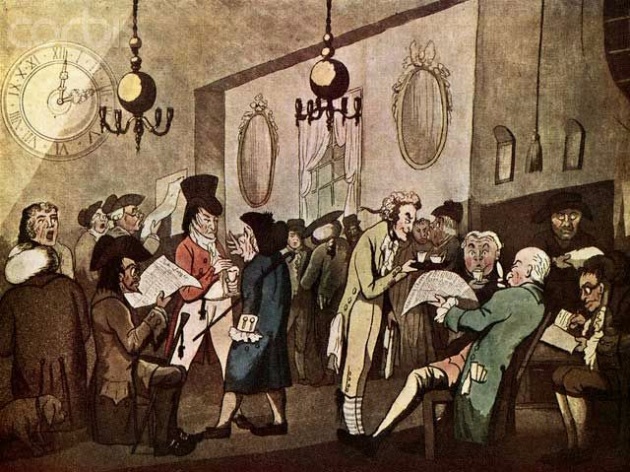 In the 18th century, London coffee houses were favorite meeting places for literary circles. Met of letters met to discuss new ideas.
In the 18th century, London coffee houses were favorite meeting places for literary circles. Met of letters met to discuss new ideas.
BURNS, CHATTERTON, AND BLAKE
In the late 1700s three, very different kinds of poets stood out from the rest.
Robert Burns (1759-96) remains the beloved folk poet of Scotland. He wrote poems and songs in Scottish dialect (local speech)such as:
1. Auld Lang Syne is masterpiece sung in many parts of the world since there was a midnight strike on New Year's Eve.
2. To a Mouse3. To a Louse
6. The Cotter's Saturday Night
7. Red Red Rose is a famous poem whose words were later set to music in which the first two lines are, 'My love is like a red, red rose, That's newly sprung in June...'
Thomas Chatterton (1752-70), the 'marvelous boy', seemed to be developing into a wonderful poet when just a school boy. But he was so poor and unhappy that he poisoned himself before he was 18. Among his greatest works is a play in verse caller 'Alla'.
William Blake (1757-1827) was unlike any other poet of the 18th century. As a writer and artist, he stands alone, a strange figure, far ahead of his time. The son of a stocking maker, he did not go to school but was apprenticed to an engraver. He became a master of that art. Educating himself, Blake became a visionary, imagining and experiencing things that others found hard to understand. His wife once said,
'I have very little of Mr. Blake's company. He is always in a paradise.'
His poetry has special forms and meanings all its own. His most famous poem 'The Tiger' comes from a collection of poems called Songs of Experience. The first verse is:
Tiger! Tiger! burning bright
In the forest of the night.
What immortal hand or eye
Could frame thy fearful symmetry?
THE ROMANTIC POETS
In the early 10th century, the Industrial Revolution was changing England into a nation of factories and tall chimneys. Abroad, Napoleon's war was sweeping across Europe. Perhaps those violent and ugly events drove the poets and other writers to try and escape into a world of their own making.
The first part of the 19th century, then, is known as the Romantic period in English literature. Poets, especially, were concerned with imagination, feelings, and emotion.
The Romantic period began about 1798. It was then that two poets combined their poems in a volume called Lyrical Ballads. The poets were William Wordsworth (1770-1850) and Samuel Taylor Coleridge (1772-1834).
Lyrical Ballads included Wordsworth's poem 'Lines Composed a Few Miles Above Tintern Abbey'. It brought to poetry the pain language that was spoken by people in everyday life and influenced many other writers. Wordsworth was born in Cumberland, near the Lake District, and was inspired by nature and the lives of the country people. Among his well-loved poems are 'Daffodils', 'My Heart Leaps When I Behold', and the long poem, based on events in his own life, called The Prelude. 'Daffodils' begins:
I wandered lonely as a cloud
That floats on high o'er vales and hills,
When all at once I saw a crowd,
A host of golden daffodils;
Beside the lake, beneath the trees,
Fluttering and dancing in the breeze.
Coleridge's most famous poem, 'The Rime of the Ancient Mariner;, also appeared in Lyrical Ballads. Gripping and mysterious, it tells of a tragic voyage to the South Pole. After an act of cruelty-shooting, a bird called an albatross-the mariner is condemned to travel forever from land to land and to teach, by his example, love and reverence for all God's creatures.
Like Wordsworth, Coleridge understood and loved nature. But his poems are more mysterious and intense. probably his most beautiful poem is the often quoted 'Kubla Khan', which begins:
In Xanadu di Kubla Khan
A stately pleasure dome decree:
Where Alph, the sacred river, ran
Through caverns measureless to man
Down to a sunless sea.
Coleridge wrote the poem after awakening from a dream in which he said he had seen the whole of the poem. The fragment that remains is only part of it. While he was writing the poem down, he was interrupted, and when he returned to finish it he could no longer remember the rest.
Three Who Reached the Heights
Three of England's greatest poets brought the Romantic movement to its height. All three- Lord Byron, John Keats and Percy Bysshe Shelley-were romantic and tragic figures.
Gordon George, Lord Byron (1788-1824) was lame for birth and ill for much of his life. At the age of 24, he published two cantos (divisions) of Childe Harold's Pilgrimage, a story-poem about man's struggle for freedom. Byron said of the praise it brought him,
'I awoke one morning and found myself famous.'
For several years, he was the darling of the London society. The romantic verse tales 'The Giaour', 'The Corsair' and 'Lara' followed soon afterward.
It was not long before scandals about his married life forced Byron to leave England. For the remainder of his life, he lived on the continent of Europe, visiting Switzerland, Venice, Ravenna, Pisa, and Genoa. Part of this time was spent with a poet Shelley. At the age of 36, Byron caught fever in Greece and died there.
Byron's Poems:
- Manfred in which the hero sells himself to the Prince of Darkness
- Don Juan which owes its title and parts of its story to an old legend of the great lover of the same name
- So, Well Go No More A- is a delightful short poetry
John Keats (1795-1821 was a brilliant poet who began to write at an early age. He came from a poor family-his father kept a stable, where horses could be hired. But while still a youth, Keats met important writers who helped him to publish his first sonnets. One of his best, 'On First Looking into Chapman's Homer', was published when he was 21. With the help of his friend Shelley, Keat's first book of poetry appeared in 1817. Three years later, Keats sailed for Italy in the hope of improving his health. But he died of tuberculosis when he reached Rome. He was 25.
Keats poems have a 'rightness' about them that few other poets have been able to match. He could make pictures with words, and nowhere is his art greater than in the poems 'Ode to a Nightingale' and 'Ode on a Grecian Urn'. His opening line to 'Endymion' is one of the best known in the whole of poetry- 'A thing of beauty is a joy forever.'
The third great romantic poet, Percy Bysshe Shelley (1792-1822), was a man of high ideals and aims. He believed that poetry could inspire people to get rid of the evils in the world. A man of noble birth, and a rebel by nature, he also left England to live in Italy. Like him, Shelley also died tragically young.
At the age of 30, he was drowned while out sailing. Byron was one of the small parties who watched the burning of Shelley's body on the beach at Viareggio. His ashes were buried in Rome near the grave of Keats.
Among Shelley's best-known poems best known for their lyrical drama:
- Prometheus Unbound
- Adonis a lament on the death of Keats
- Ode to the West Wind
- Ode to Skylark with latter begins:
Hail to thee, blithe spirit!
Bird thou never wert-
That from heaven or near it
Pourest thy full heart
In profuse strains of unpremeditated art.
Byron was a romantic and flamboyant figure. At one time adored by London society, he later left England to spend the rest of his life abroad.
VICTORIAN VERSE
With the start of Queen Victoria's reign in 1837, sentiment, satire, and more modern realistic writing replaced the romantic spirit.
Alfred, Lord Tennyson (1809-92) is often called the 'voice' of Victorian England. His re-telling of the legends of King Arthur called the Idylls of the King, whose how much the Victorians felt that moral standards should be upheld, at leat outwardly. In Memoriam is one of Tennyson's major works. Written after the death of his friend Arthur Hallam, questions religious faith in the light of scientific discoveries. Tennyson was made poet laureate in the year that the poem was published. One of Tennyson's best-known poems is 'The Lady of Shalott', which begins:
On another side of the river lie
Long fields of barley and of rye,
The clothe the world and meet the sky;
And through the field, the road runs by
To many-towered Camelot;
And up and down the people go,
Gazing where the lilies blow,
Round an island there below,
The island of Shalott.
Robert Browning (1812-89) was thought of by the Victorians as much more difficult poet, though everyone could understand his children's poem 'The Pied Piper of Hamelin'. Browning created a new poetic form the dramatic monolog. One person 'speaks' and gives the background, setting, and action of an important event in his life. Two of Browing's best-known poems- 'Andrea Del Sarto' and 'My last Duchess'-are dramatic monologs. The Ring and the Book are his longest and most ambitious poem.
Browning's wife, Elizabeth Barret Browning (1806-61) was also a poet. her best work is the collection, Sonnets from the Portuguese.
Dante Gabriel Rossetti (1828-82), his sister Christina Rossetti (1830-1909), Algernon Charles Swinburne (1837-1909)) and William Morris (1834-96) were a group who rebelled against the poetry and painting of the Victorian Age. They called themselves the Pre-Raphaelite Brotherhood. Their aim was a closer awareness of nature and return to the spirit of the Italian painters before the time of Raphael (1483-1520).
Two other poets of the Victorian Age were Gerard Manley Hopkins(1844-89), whose poetry influenced many poets of our own time; and Edward FitzGerald (1809-83) who gained fame with a single work, The Rubaiyat of Omar Khayyam.
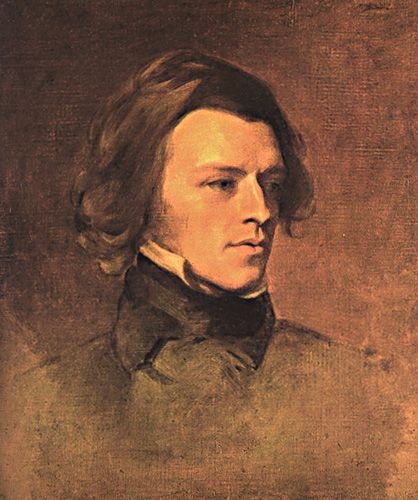 Tennyson-the 'voice' of Victorian England.
Tennyson-the 'voice' of Victorian England.
POETRY OF OUR TIME
Both America and England claim the poet T.S (Thomas Stears) Eliot (1888-1965), for he was born in America but became a British subject. No poet has a greater influence on 20th-century poetry. With 'The Love Song of J. Alfred Prufrock' and 'The Waste Land', Eliot made a complete break with the romantic poetry of the past. He became the spokesman for all those saddened bu the harshness and falseness of 20th-century civilization.
Other important poets of our times are Robert Bridges (1844-1930), Walter de la Mare(1873-1956), C.Day Lewis (1904-1972), W.H Auden(19007-73), Stephen Pender(1909-) and the Welsh poet Dylan Thomas (1914-53).
Perhaps the greatest English-language poet of the 20th century has William Butler Yeats (1865-1939). Few poets of any ages have equaled the power and variety of Yeat's language and feeling.
